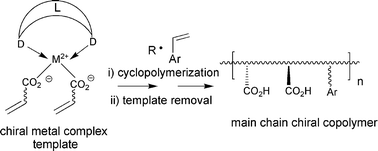Seven chiral methacrylate metal complexes have been prepared: (−)-sparteine Cu(II) dimethacrylate, CMS, (S)-(−)-nicotine Cu(II) tetramethacrylate, CMN, (−)-sparteine Zn(II) dimethacrylate, ZMS, (−)-sparteine Zn(II) diacrylate, ZAS, (−)-sparteine Zn(II) bis(3-vinyl benzoate), Z3VBS, (−)-sparteine Zn(II) bis(4-vinyl benzoate), Z4VBS, and (1R, 2R)-(−)-diaminocyclohexane Zn(II) diacrylate, ZADAC, and their X-ray crystal structures established. Each of these has been examined in free radical copolymerization reactions, primarily with electron rich styrene-type monomers (VAr) to investigate the possibility of chirality being transferred from the respective metal complexes to the backbone of the derived copolymers, the chiral metal complex template having previously been cleaved and removed. In the case of CMS and CMN no copolymer products were obtained and it seems that side reactions involving the Cu(II) redox centre inhibit the polymerization of the methacrylate anions. In contrast ZMS and ZAS readily yield a range of methacrylic acid (MAA)-co-VAr polymers which are optically active by virtue only of the configuration of the stereogenic carbon atoms along the backbone i.e., copolymers have been synthesized in which the chirality has been transferred from the ZMS or ZAS to the respective copolymer backbone. The most reasonable rationalization for this is that the dimethacrylate ligands in these two Zn(II) complexes undergo selective cyclopolymerization under the stereochemical control of the (−)-sparteine ligand followed by reaction with an electron rich VAr molecule, to yield asymmetric Wulff-type triads along the polymer backbone. Cleavage of the (−)-sparteine Zn(II) templates reveals the inherent optical activity of the copolymer main chains. Despite a number of attempts similar experiments with Z3VBS and Z4VBS yielded only optically inactive copolymers once the chiral (−)-sparteine Zn(II) template was removed, and so it seems that chirality transfer does not occur with these complexes. Inspection of the respective crystal structures shows that the styryl carbon–carbon double bonds in these two complexes are well removed from the Zn(II) centre and almost certainly from the stereochemical influence of the (−)-sparteine ligand. They are also sufficiently remote from each other for selective cyclopolymerization to be disfavoured. In the case of ZADAC it proved impossible to isolate any soluble copolymers from the gels that were produced when this complex was subjected to copolymerization. It seems therefore that the much more conformationally mobile chiral diaminocyclohexane ligand in this complex allows the two diacrylate ligands to undergo copolymerization essentially independently of each other, and without any stereochemical control, giving rise to intractable crosslinked products.


 Please wait while we load your content...
Please wait while we load your content...